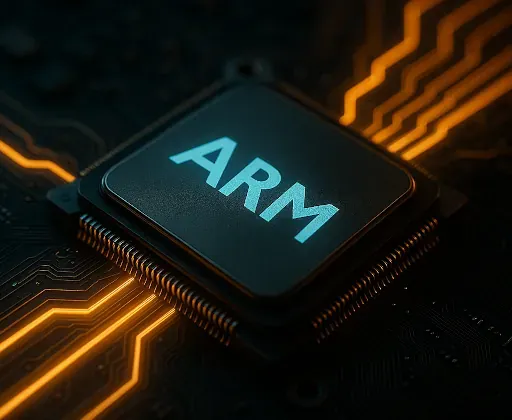Hello! In my last post, I explored the fascinating competition between two giants, Intel and AMD, focusing on the 'brain' of computers, CPU, and the x86, x64 architecture. Today, continuing that narrative, I will delve deeper into another powerful CPU architecture that even forced the rivals Intel and AMD to cooperate: ARM. I will also touch on the important roles played by Snapdragon and Raspberry Pi within the ARM ecosystem.
1. What is ARM? The Power of RISC-Based Architecture
ARM (Advanced RISC Machines), as the name suggests, is a Reduced Instruction Set Computing (RISC) architecture. In the previous post, I mentioned that x86 is based on CISC (Complex Instruction Set Computing). This is where ARM's core strengths begin.
-
RISC vs. CISC:
-
CISC (x86): Designed to perform multiple complex tasks with a single instruction, making it flexible. However, its instruction interpretation can be complicated, and it may consume relatively high power.
-
RISC (ARM): Reduces the number of instructions and simplifies each instruction. This results in faster and more efficient instruction processing, and above all, outstanding power efficiency. This has proven to be an overwhelming advantage in environments where battery life is crucial, like mobile devices.
-
ARM does not produce CPUs directly but offers architecture design licenses. Numerous semiconductor companies like Qualcomm, Samsung, Apple, and MediaTek create their own CPUs based on ARM's designs.
2. Snapdragon: Qualcomm's Powerful ARM-Based SoC
So, what exactly is Snapdragon? It is a series of System on Chip (SoC) products developed and sold by Qualcomm.
-
What is SoC? SoC integrates almost all the core components needed for smartphone operation, including not just CPU but also GPU (graphics processing unit), communication modem, image signal processor (ISP), and neural processing unit (NPU), into a single chip. Think of it as the entire motherboard of a computer compressed into one chip.
-
ARM Architecture Based: The core CPU of Snapdragon is designed based on ARM architecture. Qualcomm obtains an architecture license from ARM to create custom CPU cores (e.g., Kryo) or utilize standard cores provided by ARM (e.g., Cortex-A series) to produce Snapdragon SoCs.
-
Samsung and Snapdragon: Samsung's Galaxy is also related to Snapdragon. Samsung develops its own ARM-based SoC called Exynos, but at the same time, they also use Qualcomm's Snapdragon chips in flagship Galaxy smartphones. In the past, they divided usage between Exynos and Snapdragon by region, but recently, due to the performance advantage of Snapdragon chips, many models have started featuring Snapdragon. So, you can understand that Snapdragon is not Samsung's ARM chip but rather Qualcomm's ARM-based chip used in Samsung products.
Snapdragon boasts a dominant market share in the global Android smartphone market, backed by its excellent performance, power efficiency, and communication modem technology.
3. ARM: Mastering the Mobile Market Beyond x86
Initially, ARM was mainly used in embedded systems or portable devices. With the advent of smartphones, the true power of ARM began to shine. Every smartphone, whether it’s an iPhone or an Android phone, is equipped with an ARM-based processor.

-
Battery Efficiency: One of the most important factors for smartphones is battery life. ARM's excellent power efficiency meets this requirement perfectly.
-
Small Size and Low Cost: Thanks to the simplicity of the RISC architecture, chip size can be reduced, and production costs lowered.
Having completely dominated the mobile market, ARM has now transcended beyond mobile chips. ARM-based chips are being used in countless devices around us, including wearable devices, Internet of Things (IoT) devices, smart TVs, and automotive infotainment systems.
4. x86 vs. ARM: The New War in the PC and Server Markets
Having conquered the mobile market, ARM is now extending its influence into the PC and server markets, long dominated by x86. Notably, Apple switched its Mac lineup from Intel x86 processors to their own developed Apple Silicon (M-series chips) in 2020, which has sparked attention on the performance of ARM-based PCs by breaking previous biases.
-
Entering the PC Market:
-
Apple Silicon: Apple's ARM-based chips like M1, M2, and M3 showcase remarkable performance and power efficiency, creating a significant impact in the PC market. Especially, the ability to perform at high levels even in fanless laptops is a clear differentiator from x86-based laptops.
-
Windows on ARM: Microsoft is also collaborating with companies like Qualcomm (Snapdragon X Elite) to develop ARM-based Windows PCs. While there are still challenges with software compatibility, the potential is substantial.
-
-
Entering the Server Market:
-
Cloud Computing: ARM-based server chips, such as AWS's Graviton processors, are increasingly being used in data centers. They offer high performance with low power consumption, reducing operational costs.
-
Customizability: ARM's licensing model allows companies to design custom chips optimized for specific workloads.
-
Response from the x86 Alliance: Intel and AMD are feeling the pressure from ARM's rise. They are working to enhance the power efficiency of existing x86 processors and further boost performance.
5. The Small Giant, Raspberry Pi, Also Based on ARM!
The Raspberry Pi, known for being a small and affordable computer, is also based on ARM architecture. Initially developed for educational purposes, it is now utilized in various projects including IoT, home automation, media servers, and small robots, gaining immense popularity.
-
ARM Cortex Core: The core of the Raspberry Pi is a SoC produced by Broadcom, which includes ARM's Cortex-A series CPU core.
- For example, Raspberry Pi 4 uses an ARM Cortex-A72 core, and the latest Raspberry Pi 5 uses a more powerful ARM Cortex-A76 core.
-
Spreading the ARM Ecosystem: The success of Raspberry Pi is a prime example of how the ARM architecture can be utilized as a powerful and affordable general-purpose computing platform, extending beyond just smartphones.
6. ARM and x86, and the Future of the CPU Ecosystem
The current CPU market is experiencing an exciting era with two massive architectures, x86 and ARM, coexisting and competing fiercely.
-
Maintaining Individual Strengths: x86 still holds a strong position in high-performance computing, gaming, and specific professional tasks. In contrast, ARM is rapidly growing in the mobile, embedded, and lightweight PC and server markets, where power efficiency is critical.
-
Software Compatibility: For ARM-based systems to proliferate widely, issues of software compatibility must be resolved. While emulation technologies like Rosetta 2 are advancing, more native ARM app development needs to be activated. One reason many PC games do not run on MacOS is that many game developers create games based on x86 architecture, as it has a larger user base. Therefore, for the ARM CPU market to grow, the efforts and contributions of software development companies are crucial.
-
Hybrid Systems: In the future, we may see diverse computing environments where hybrid systems combining the advantages of both architectures coexist, or various architectures optimized for specific tasks.
As Intel and AMD work to solidify the x86 ecosystem in response to ARM's rise, ARM is expanding its territory and driving innovation. I’m excited to see what remarkable technological advancements this intriguing competition will bring in the future.
In Conclusion
Today, we explored the ARM architecture, the ruler of the mobile market and a formidable challenger in the PC and server arenas. We also looked at Snapdragon as a major player in the ARM ecosystem and the small but powerful Raspberry Pi.
Are you using ARM-based devices? Or do you still prefer x86-based systems? What architecture do you think will dominate future computing? Share your thoughts in the comments! I look forward to bringing you another exciting IT story in the next post. Thank you!

There are no comments.